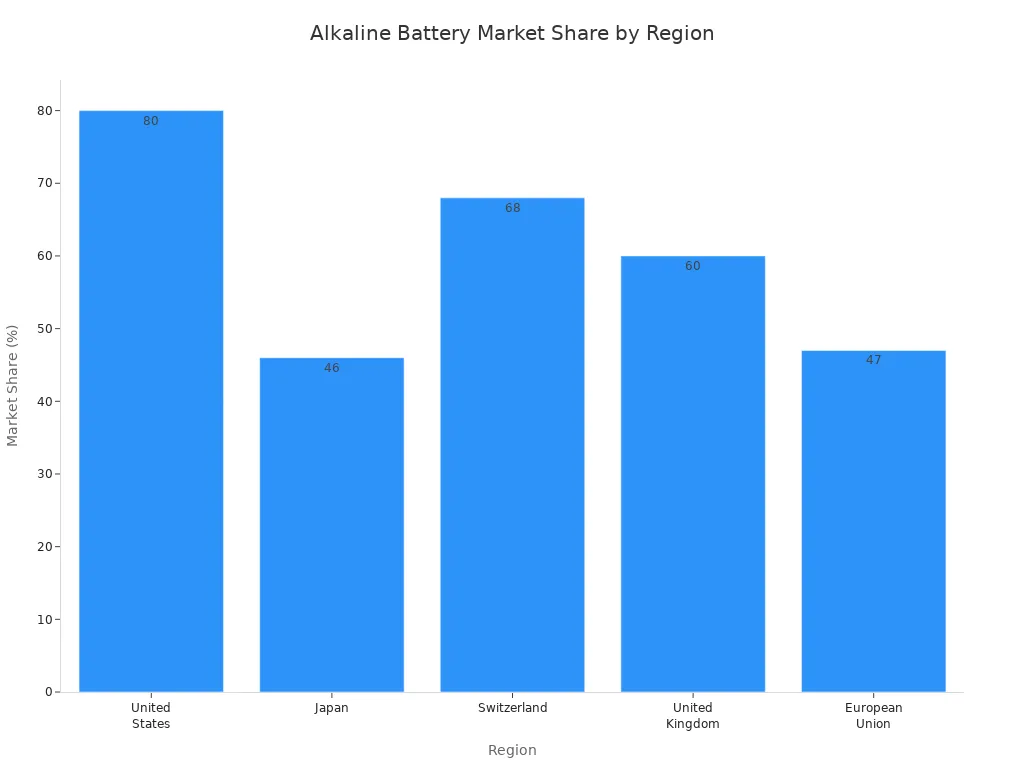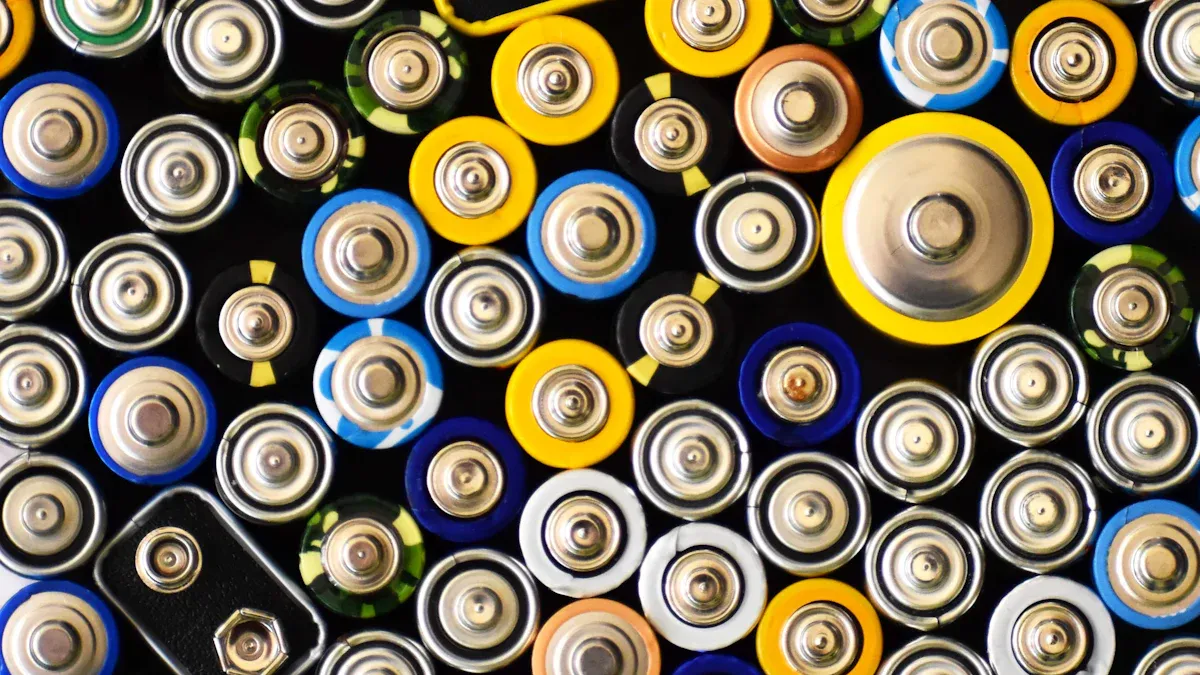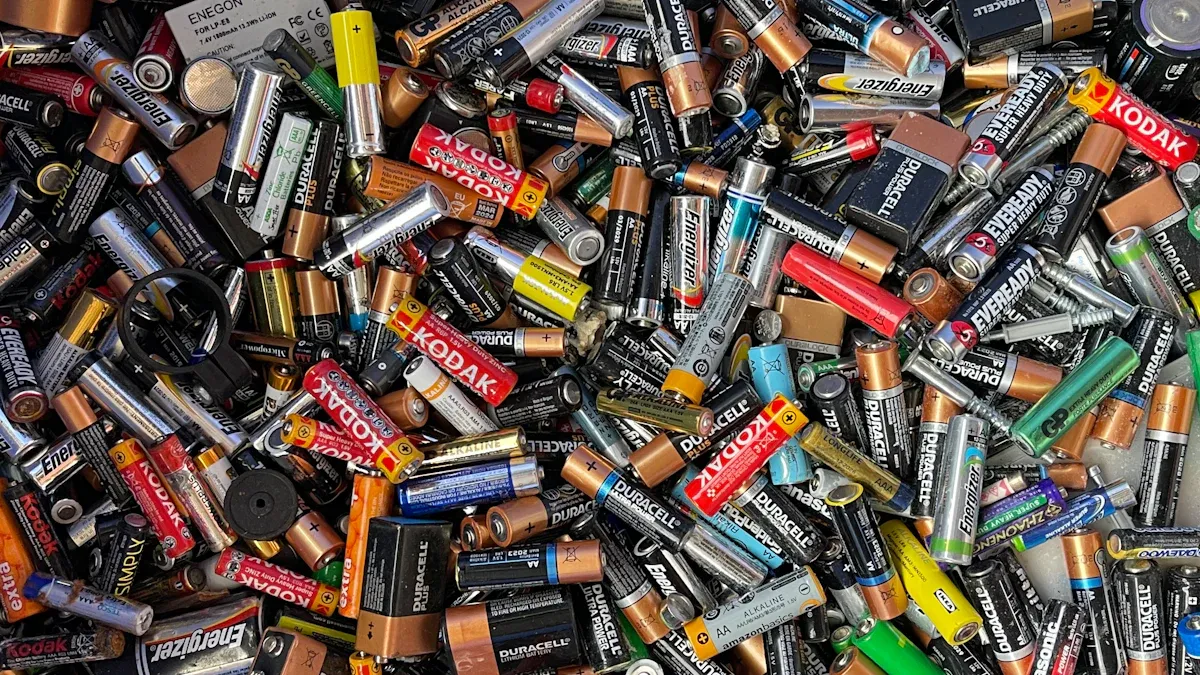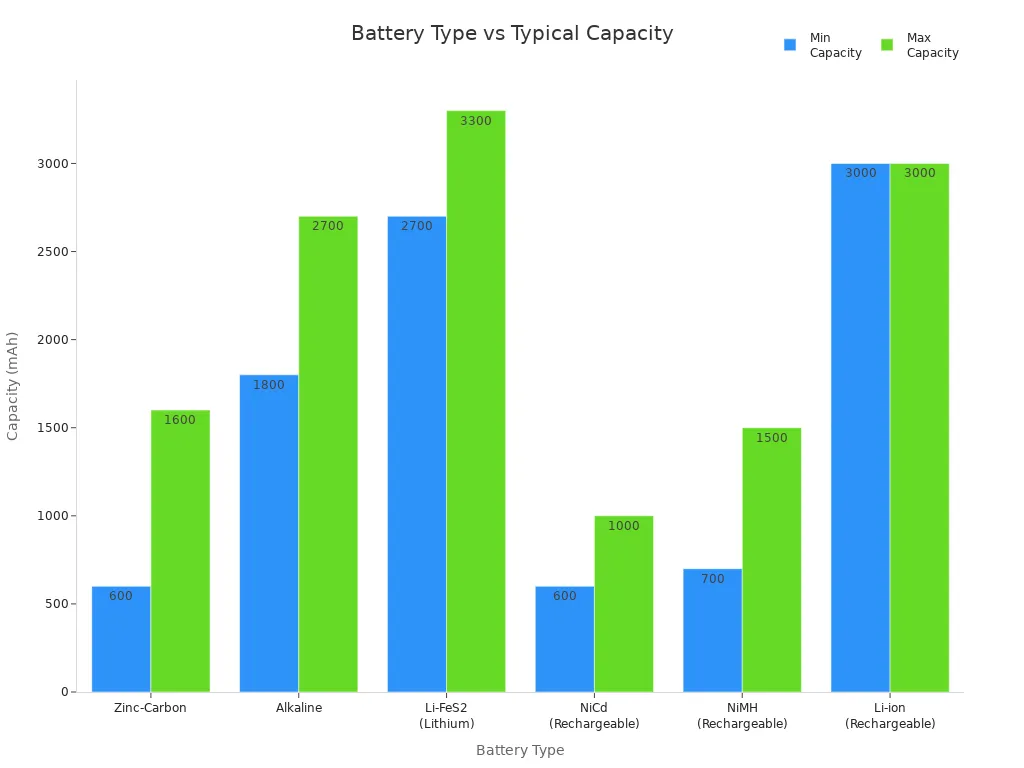I see the alkaline battery as a staple in daily life, powering countless devices reliably. Market share numbers highlight its popularity, with the United States reaching 80% and the United Kingdom at 60% in 2011.

As I weigh environmental concerns, I recognize that choosing batteries impacts both waste and resource use. Manufacturers now develop safer, mercury-free options to support sustainability while maintaining performance. Alkaline batteries continue to adapt, balancing eco-friendliness with dependable energy. I believe this evolution strengthens their value in a responsible energy landscape.
Making informed battery choices protects both the environment and device reliability.
Key Takeaways
- Alkaline batteries power many everyday devices reliably while evolving to be safer and more eco-friendly by removing harmful metals like mercury and cadmium.
- Choosing rechargeable batteries and practicing proper storage, use, and recycling can reduce waste and environmental harm from battery disposal.
- Understanding battery types and matching them to device needs helps maximize performance, save money, and support sustainability.
Alkaline Battery Basics

Chemistry and Design
When I look at what sets the alkaline battery apart, I see its unique chemistry and structure. The battery uses manganese dioxide as the positive electrode and zinc as the negative electrode. Potassium hydroxide acts as the electrolyte, which helps the battery deliver a steady voltage. This combination supports a reliable chemical reaction:
Zn + MnO₂ + H₂O → Mn(OH)₂ + ZnO
The design uses an opposite electrode structure, which increases the area between the positive and negative sides. This change, along with using zinc in granule form, boosts the reaction area and improves performance. The potassium hydroxide electrolyte replaces older types like ammonium chloride, making the battery more conductive and efficient. I notice that these features give the alkaline battery a longer shelf life and better performance in high-drain and low-temperature situations.
The chemistry and design of alkaline batteries make them dependable for many devices and environments.
| Feature/Component | Alkaline Battery Details |
|---|---|
| Cathode (Positive Electrode) | Manganese dioxide |
| Anode (Negative Electrode) | Zinc |
| Electrolyte | Potassium hydroxide (aqueous alkaline electrolyte) |
| Electrode Structure | Opposite electrode structure increasing relative area between positive and negative electrodes |
| Anode Zinc Form | Granule form to increase reaction area |
| Chemical Reaction | Zn + MnO₂ + H₂O → Mn(OH)₂ + ZnO |
| Performance Advantages | Higher capacity, lower internal resistance, better high-drain and low-temperature performance |
| Physical Characteristics | Dry cell, disposable, long shelf life, higher current output than carbon batteries |
Typical Applications
I see alkaline batteries used in almost every part of daily life. They power remote controls, clocks, flashlights, and toys. Many people rely on them for portable radios, smoke detectors, and wireless keyboards. I also find them in digital cameras, especially disposable types, and in kitchen timers. Their high energy density and long shelf life make them a top choice for both household and portable electronics.
- Remote controls
- Clocks
- Flashlights
- Toys
- Portable radios
- Smoke detectors
- Wireless keyboards
- Digital cameras
Alkaline batteries also serve in commercial and military applications, such as ocean data collection and tracking devices.
Alkaline batteries remain a trusted solution for a wide range of everyday and specialized devices.
Alkaline Battery Environmental Impact

Resource Extraction and Materials
When I examine the environmental impact of batteries, I start with the raw materials. The main components in an alkaline battery include zinc, manganese dioxide, and potassium hydroxide. Mining and refining these materials require a lot of energy, often from fossil fuels. This process releases significant carbon emissions and disrupts land and water resources. For example, mining operations for minerals can emit large amounts of CO₂, showing the scale of environmental disruption involved. Even though lithium is not used in alkaline batteries, its extraction can emit up to 10 kg of CO₂ per kilogram, which helps illustrate the broader impact of mineral extraction.
Here is a breakdown of the key materials and their roles:
| Raw Material | Role in Alkaline Battery | Significance and Impact |
|---|---|---|
| Zinc | Anode | Critical for electrochemical reactions; high energy density; affordable and widely available. |
| Manganese Dioxide | Cathode | Provides stability and efficiency in energy conversion; enhances battery performance. |
| Potassium Hydroxide | Electrolyte | Facilitates ion movement; ensures high conductivity and battery efficiency. |
I see that the extraction and processing of these materials contribute to the overall environmental footprint of the battery. Sustainable sourcing and cleaner energy in production can help reduce this impact.
The choice and sourcing of raw materials play a major role in the environmental profile of every alkaline battery.
Manufacturing Emissions
I pay close attention to the emissions produced during battery manufacturing. The process uses energy to mine, refine, and assemble the materials. For AA alkaline batteries, the average greenhouse gas emissions reach about 107 grams of CO₂ equivalent per battery. AAA alkaline batteries emit around 55.8 grams of CO₂ equivalent each. These numbers reflect the energy-intensive nature of battery production.
| Battery Type | Average Weight (g) | Average GHG Emissions (g CO₂eq) |
|---|---|---|
| AA Alkaline | 23 | 107 |
| AAA Alkaline | 12 | 55.8 |
When I compare alkaline batteries to other types, I notice that lithium-ion batteries have a higher manufacturing impact. This is due to the extraction and processing of rare metals like lithium and cobalt, which require more energy and cause more environmental harm. Zinc-carbon batteries have a similar impact to alkaline batteries because they use many of the same materials. Some zinc-alkaline batteries, such as those from Urban Electric Power, have shown lower manufacturing carbon emissions than lithium-ion batteries, which suggests that zinc-based batteries can offer a more sustainable choice.
| Battery Type | Manufacturing Impact |
|---|---|
| Alkaline | Medium |
| Lithium-ion | High |
| Zinc-carbon | Medium (implied) |
Manufacturing emissions are a key factor in the environmental impact of batteries, and choosing cleaner energy sources can make a big difference.
Waste Generation and Disposal
I see waste generation as a major challenge for battery sustainability. In the United States alone, people purchase about 3 billion alkaline batteries each year, with over 8 million discarded daily. Most of these batteries end up in landfills. Although modern alkaline batteries are not classified as hazardous waste by the EPA, they can still leach chemicals into groundwater over time. The materials inside, such as manganese, steel, and zinc, are valuable but difficult and costly to recover, which leads to low recycling rates.
- About 2.11 billion single-use alkaline batteries are discarded annually in the U.S.
- 24% of discarded alkaline batteries still contain significant residual energy, showing that many are not fully used.
- 17% of collected batteries have not been used at all before disposal.
- The environmental impact of alkaline batteries increases by 25% in lifecycle assessments due to underutilization.
- Environmental risks include chemical leaching, resource depletion, and wastefulness from single-use products.
I believe that improving recycling rates and encouraging full use of each battery can help reduce waste and environmental risks.
Proper disposal and efficient use of batteries are essential for minimizing environmental harm and conserving resources.
Alkaline Battery Performance
Capacity and Power Output
When I evaluate battery performance, I focus on capacity and power output. The capacity of a standard alkaline battery, measured in milliampere-hours (mAh), usually ranges from 1,800 to 2,850 mAh for AA sizes. This capacity supports a wide variety of devices, from remote controls to flashlights. Lithium AA batteries can reach up to 3,400 mAh, offering higher energy density and longer runtime, while NiMH rechargeable AA batteries range from 700 to 2,800 mAh but operate at a lower voltage of 1.2V compared to the 1.5V of alkaline batteries.
The following chart compares typical energy capacity ranges across common battery chemistries:

I notice that alkaline batteries deliver balanced performance and cost, making them ideal for low to medium drain devices. Their power output depends on temperature and load conditions. At low temperatures, ion mobility drops, causing higher internal resistance and reduced capacity. High drain loads also decrease delivered capacity due to voltage drops. Batteries with lower internal impedance, such as specialized models, perform better under demanding conditions. Intermittent use allows voltage recovery, extending battery life compared to continuous discharge.
- Alkaline batteries work best at room temperature and moderate loads.
- Extreme temperatures and high drain applications reduce effective capacity and runtime.
- Using batteries in series or parallel can limit performance if one cell is weaker.
Alkaline batteries provide reliable capacity and power output for most everyday devices, especially under normal conditions.
Shelf Life and Reliability
Shelf life is a critical factor when I select batteries for storage or emergency use. Alkaline batteries typically last between 5 and 7 years on the shelf, depending on storage conditions such as temperature and humidity. Their slow self-discharge rate ensures that they retain most of their charge over time. In contrast, lithium batteries can last 10 to 15 years when stored properly, and rechargeable lithium-ion batteries offer over 1,000 charge cycles with a shelf life of about 10 years.
Reliability in consumer electronics depends on several metrics. I rely on technical performance tests, consumer feedback, and device operation stability. Voltage stability is essential for consistent power delivery. Performance under different load conditions, such as high-drain and low-drain scenarios, helps me assess real-world effectiveness. Leading brands like Energizer, Panasonic, and Duracell often undergo blind testing to compare device performance and identify top performers.
- Alkaline batteries maintain stable voltage and reliable operation in most devices.
- Shelf life and reliability make them suitable for emergency kits and infrequent-use devices.
- Technical tests and consumer feedback confirm their consistent performance.
Alkaline batteries offer dependable shelf life and reliability, making them a trusted choice for both regular and emergency use.
Device Compatibility
Device compatibility determines how well a battery meets the needs of specific electronics. I find that alkaline batteries are highly compatible with everyday devices such as TV remotes, clocks, flashlights, and toys. Their stable 1.5V output and capacity range from 1,800 to 2,700 mAh match the requirements of most household electronics. Medical devices and emergency equipment also benefit from their reliability and moderate drain support.
| Device Type | Compatibility with Alkaline Batteries | Key Factors Influencing Compatibility |
|---|---|---|
| Everyday Electronics | High (e.g., TV remotes, clocks, flashlights, toys) | Moderate to low power drain; stable 1.5V voltage; capacity 1800-2700 mAh |
| Medical Devices | Suitable (e.g., glucose monitors, portable blood pressure monitors) | Reliability critical; moderate drain; voltage and capacity matching important |
| Emergency Equipment | Suitable (e.g., smoke detectors, emergency radios) | Reliability and stable voltage output essential; moderate drain |
| High-Performance Devices | Less suitable (e.g., high-performance digital cameras) | Often require lithium or rechargeable batteries due to higher drain and longer life needs |
I always check device manuals for recommended battery types and capacities. Alkaline batteries are cost-effective and widely available, making them practical for occasional use and moderate power needs. For high-drain or portable devices, lithium or rechargeable batteries may offer better performance and longer life.
- Alkaline batteries excel in low to moderate drain devices.
- Matching battery type to device requirements maximizes efficiency and value.
- Cost-effectiveness and availability make alkaline batteries a popular choice for most households.
Alkaline batteries remain the preferred solution for everyday electronics, providing reliable compatibility and performance.
Innovations in Alkaline Battery Sustainability
Mercury-Free and Cadmium-Free Advances
I have seen major progress in making alkaline batteries safer for people and the planet. Panasonic started producing mercury-free alkaline batteries in 1991. The company now offers carbon zinc batteries that are free from lead, cadmium, and mercury, especially in its Super Heavy Duty line. This change protects users and the environment by removing toxic metals from battery production. Other manufacturers, such as Zhongyin Battery and NanFu Battery, also focus on mercury-free and cadmium-free technology. Johnson New Eletek uses automated production lines to maintain quality and sustainability. These efforts show a strong industry move toward eco-friendly and safe alkaline battery manufacturing.
- Mercury-free and cadmium-free batteries reduce health risks.
- Automated production improves consistency and supports green goals.
Removing toxic metals from batteries makes them safer and better for the environment.
Reusable and Rechargeable Alkaline Battery Options
I notice that single-use batteries create a lot of waste. Rechargeable batteries help solve this problem because I can use them many times. Rechargeable alkaline batteries last for about 10 full cycles, or up to 50 cycles if I do not fully discharge them. Their capacity drops after each recharge, but they still work well for low-drain devices like flashlights and radios. Nickel-metal hydride rechargeable batteries last much longer, with hundreds or thousands of cycles and better capacity retention. Although rechargeable batteries cost more at first, they save money over time and reduce waste. Proper recycling of these batteries helps recover valuable materials and lowers the need for new resources.
| Aspect | Reusable Alkaline Batteries | Rechargeable Batteries (e.g., NiMH) |
|---|---|---|
| Cycle Life | ~10 cycles; up to 50 at partial discharge | Hundreds to thousands of cycles |
| Capacity | Drops after first recharge | Stable over many cycles |
| Usage Suitability | Best for low-drain devices | Suitable for frequent and high-drain use |
Rechargeable batteries offer better environmental benefits when used and recycled properly.
Recycling and Circularity Improvements
I see recycling as a key part of making alkaline battery use more sustainable. New shredding technologies help process batteries safely and efficiently. Customizable shredders handle different battery types, and single-shaft shredders with changeable screens allow for better particle size control. Low-temperature shredding reduces hazardous emissions and improves safety. Automation in shredding plants increases the amount of batteries processed and helps recover materials like zinc, manganese, and steel. These improvements make recycling easier and support a circular economy by reducing waste and reusing valuable resources.
- Advanced shredding systems improve safety and material recovery.
- Automation boosts recycling rates and lowers costs.
Better recycling technology helps create a more sustainable future for battery use.
Alkaline Battery vs. Other Battery Types
Comparison with Rechargeable Batteries
When I compare single-use batteries to rechargeable ones, I notice several important differences. Rechargeable batteries can be used hundreds of times, which helps reduce waste and saves money over time. They work best in high-drain devices like cameras and game controllers because they deliver steady power. However, they cost more at first and need a charger. I find that rechargeable batteries lose charge faster when stored, so they are not ideal for emergency kits or devices that sit unused for long periods.
Here is a table that highlights the main differences:
| Aspect | Alkaline Batteries (Primary) | Rechargeable Batteries (Secondary) |
|---|---|---|
| Rechargeability | Non-rechargeable; must be replaced after use | Rechargeable; can be used multiple times |
| Internal Resistance | Higher; less suited for current spikes | Lower; better peak power output |
| Suitability | Best for low-drain, infrequent use devices | Best for high-drain, frequently used devices |
| Shelf Life | Excellent; ready to use from shelf | Higher self-discharge; less suitable for long-term storage |
| Environmental Impact | More frequent replacements lead to more waste | Reduced waste over lifetime; greener overall |
| Cost | Lower initial cost; no charger needed | Higher initial cost; requires charger |
| Device Design Complexity | Simpler; no charging circuitry needed | More complex; needs charging and protection circuitry |
Rechargeable batteries are better for frequent use and high-drain devices, while single-use batteries are best for occasional, low-drain needs.
Comparison with Lithium and Zinc-Carbon Batteries
I see that lithium batteries stand out for their high energy density and long life. They power high-drain devices like digital cameras and medical equipment. Recycling lithium batteries is complex and costly because of their chemistry and valuable metals. Zinc-carbon batteries, on the other hand, have lower energy density and work best in low-drain devices. They are easier and cheaper to recycle, and zinc is less toxic.
Here is a table comparing these battery types:
| Aspect | Lithium Batteries | Alkaline Batteries | Zinc-Carbon Batteries |
|---|---|---|---|
| Energy Density | High; best for high-drain devices | Moderate; better than zinc-carbon | Low; best for low-drain devices |
| Disposal Challenges | Complex recycling; valuable metals | Less viable recycling; some environmental risk | Easier recycling; more environmentally friendly |
| Environmental Impact | Mining and disposal can harm environment | Lower toxicity; improper disposal can contaminate | Zinc is less toxic and more recyclable |
Lithium batteries offer more power but are harder to recycle, while zinc-carbon batteries are easier on the environment but less powerful.
Strengths and Weaknesses
When I evaluate battery choices, I consider both strengths and weaknesses. I find that single-use batteries are affordable and easy to find. They have a long shelf life and provide steady power for low-drain devices. I can use them right out of the package. However, I must replace them after use, which creates more waste. Rechargeable batteries cost more at first but last longer and create less waste. They need charging equipment and regular attention.
- Strengths of Single-Use Batteries:
- Affordable and widely available
- Excellent shelf life
- Stable power for low-drain devices
- Ready to use immediately
- Weaknesses of Single-Use Batteries:
- Non-rechargeable; must be replaced after depletion
- Shorter lifespan than rechargeable batteries
- More frequent replacements increase electronic waste
Single-use batteries are reliable and convenient, but rechargeable batteries are better for the environment and frequent use.
Making Sustainable Alkaline Battery Choices
Tips for Eco-Friendly Use
I always look for ways to reduce my environmental impact when using batteries. Here are some practical steps I follow:
- Use batteries only when necessary and turn off devices when not in use.
- Choose rechargeable options for devices that need frequent battery changes.
- Store batteries in a cool, dry place to extend their life.
- Avoid mixing old and new batteries in the same device to prevent waste.
- Select brands that use recycled materials and have strong environmental commitments.
Simple habits like these help conserve resources and keep batteries out of landfills. Making small changes in battery use can lead to big environmental benefits.
Recycling and Proper Disposal
Proper disposal of used batteries protects both people and the environment. I follow these steps to ensure safe handling:
- Store used batteries in a labeled, sealable container away from heat and moisture.
- Tape the terminals, especially on 9V batteries, to prevent short circuits.
- Keep different types of batteries separate to avoid chemical reactions.
- Take batteries to local recycling centers or hazardous waste collection sites.
- Never throw batteries in regular trash or curbside recycling bins.
Safe recycling and disposal prevent pollution and support a cleaner community.
Selecting the Right Alkaline Battery
When I choose batteries, I consider both performance and sustainability. I look for these features:
- Brands that use recycled materials, like Energizer EcoAdvanced.
- Companies with environmental certifications and transparent manufacturing.
- Leak-resistant designs to protect devices and reduce waste.
- Rechargeable options for long-term savings and less waste.
- Compatibility with my devices to avoid premature disposal.
- Local recycling programs for end-of-life management.
- Reputable brands known for balancing performance and sustainability.
Choosing the right battery supports both device reliability and environmental responsibility.
I see the alkaline battery evolving with automation, recycled materials, and energy-efficient manufacturing. These advances boost performance and reduce waste.
- Consumer education and recycling programs help protect the environment.
Making informed choices ensures reliable power and supports a sustainable future.
FAQ
What makes alkaline batteries more eco-friendly today?
I see manufacturers removing mercury and cadmium from alkaline batteries. This change reduces environmental harm and improves safety.
Mercury-free batteries support a cleaner, safer environment.
How should I store alkaline batteries for best performance?
I keep batteries in a cool, dry place. I avoid extreme temperatures and humidity. Proper storage extends shelf life and maintains power.
Good storage habits help batteries last longer.
Can I recycle alkaline batteries at home?
I cannot recycle alkaline batteries in regular home bins. I take them to local recycling centers or collection events.
Proper recycling protects the environment and recovers valuable materials.
Post time: Aug-14-2025




